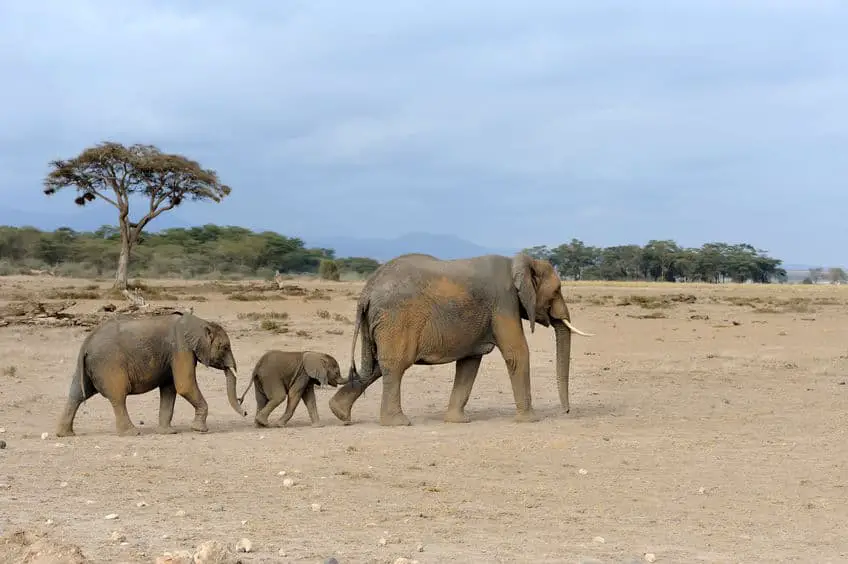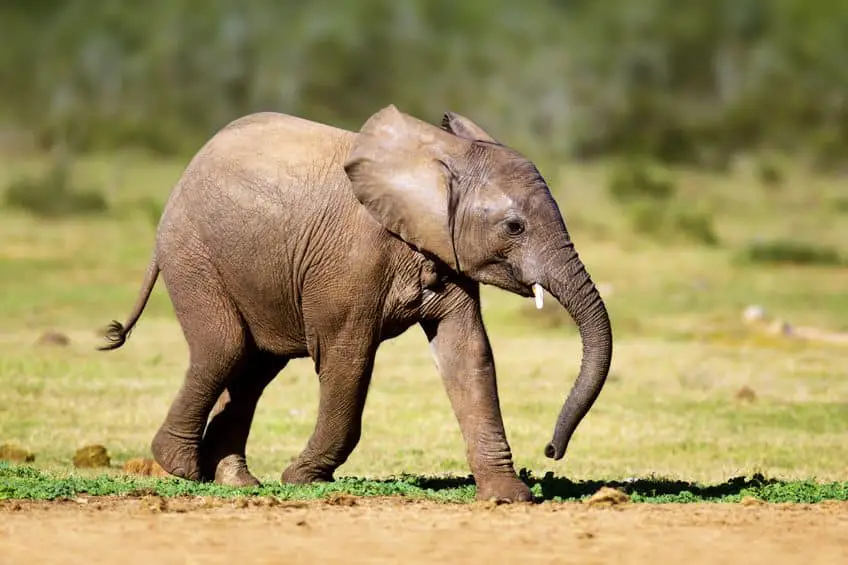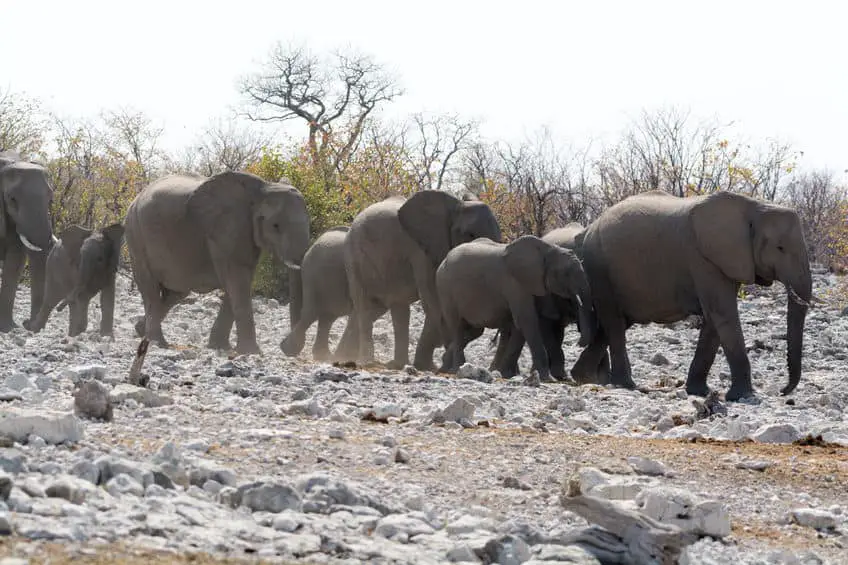
The life cycle of African elephants is fascinating and during an elephant’s life, many interesting things happen. I have written this post to describe the life cycle of African elephants in detail.
There are three stages in an elephant’s life:
- The baby stage
- Begins when the elephant is born and lasts until it no longer depends on its mother’s milk for nutrition which is typically around the age of 5-10 years.
- Adolescence
- Lasts until the elephant is around 18-20 years old. During this time, the elephant acquires and practices several important life skills. Male elephants leave their herd when they reach this stage and female elephants become more interested in helping to raise young calves.
- Adulthood
- Lasts for the rest of the elephant’s life. During this time, the elephant will produce offspring.
During all three stages of an elephant’s life, many fascinating things happen. Below, I have described in detail what those three stages are all about and what role they play in an elephant’s life cycle.
To get the full experience and see these majestic animals up close, I recommend getting a good pair of binoculars. You can get some very good ones that aren’t super expensive such as these (link to Amazon). To learn more about how to find the right binoculars for you as well as see some more recommendations, head over to this article.
The Baby Stage

After a long gestation period of 21-22 months, it is time for the mother elephant to give birth to a calf. When this is just about to happen, the other members of the herd will surround the soon-to-be mother. They do this to provide the elephant giving birth and the newborn calf with protection from curious and hungry predators who may be lurking in some nearby bushes, looking for their next meal.
After a successful birth, the herd of elephants is officially one member larger than before. The new member of the herd is a tiny (at least compared to the others) calf weighing just 90-120 kg. (200-265 lb) and standing 1 meter (3 feet) tall at birth.
Elephants almost always give birth to just one calf at the time but in very rare cases, around 1% of the time, elephants having twins have been recorded.
At birth, the new elephant calf is loosely covered in hair which helps to keep the calf cooled down by carrying heat away from its skin. The calf will lose this hair over time as it grows older.
Within just a few hours of being born, the new calf has already learned to walk and while it is still not very good at it, it is much better than not being able to walk at all and this skill will quickly improve as the calf grows older and gets to practice it. The reason why elephants learn to walk (or at least start to practice it) so early is simply to improve their chances of survival since some African predators (lions especially) can sometimes hunt elephant calves.
The newborn elephant calf gets its nutrition from its mother’s milk and will drink around 15 liters (4 gallons) every day. During this time, it will grow and increase its weight by approximately 1 kg (2,2 lb) per day.
When the calf is still this young, it is extremely clumsy and has not yet learned to control its own body. The long trunk especially can be tricky for the calf who has no idea what to do with it and even less of an idea how to control it, so it will experiment and play around with it, making it swing in circles and back and forth. Sometimes the young calf will even trip and fall over its own trunk since it has still not quite figured out how it works.
Even though it may cause some initial trouble for the calf, its trunk does serve an important purpose already at this time. The calf is not able to see very well for the first time after being born so it can use its trunk to smell and feel things around it.
Around the age of one year, however, the calf has started to learn how to control its body and it is now able to use its trunk almost like the adults for picking up food, drinking water, and grabbing things.
After getting its nutrients from its mother’s milk for around two years, the calf will begin to supplement it by adding plants to its diet. For the next few years (usually until the age of 5-10) or until the mother elephant has another calf who needs the milk, the young elephant’s diet will consist of a mix of plants and milk from its mother. After this time, the calf will no longer drink its mother’s milk and the diet will now consist of plants just like the adults’ diet.
Until the baby elephant reaches adolescence, it will live in the herd with the females (called cows) and other young elephants from its family. It will benefit enormously from having all of these extra caregivers around it as it will not only increase chances of survival but also greatly increase the calf’s ability to learn by allowing it to observe and attempt to imitate the behavior of the other elephants from the herd.
The entire herd of elephants will help the mother with raising the calf and in the unfortunate case of the mother dying, another female elephant will adopt the calf and raise it as if it was her own.
Adolescence

When the young elephant achieves sexual maturity around the age of 10-13, it reaches adolescence. This is a very vital stage of the elephant’s life as it will acquire and practice many important skills during this stage which are used to survive and thrive.
When young elephants reach adolescence, the males will leave their herd and the females will stay and help taking care of new calves until they start producing their own offspring.
Young male elephants are very sociable and will seek out other male elephants (bulls) after they leave their family and form large herds consisting of both other young male elephants and older bulls. These herds of male elephants can sometimes become very large and consist of more than 100 animals but they are not as stable as the family-herds of females and calves are and some of the males will often leave the large herds while others join.
During their time in these large herds consisting of many male elephants, the young males will learn vital life skills by observing and learning from each other and especially from the older bulls.
Opposite of the young male elephants who leave the herd once they reach adolescence, the females stay in the herd for their entire lives. Here they begin to take a deeper interest in helping to raise the other elephants’ calves and they will acquire and train skills needed for when they will have calves of their own.
When the male elephants become older, they will typically become more solitary in their nature but they can still socialize with other males and participate in the more unstable herds I described above.
Adulthood

Elephants reach adulthood around the age of 18-20 years and at this point, they have grown to become the largest land-living animal on the planet.
A fully grown male elephant weighs between 4000-6500 kg. (8820-14330 lb) and while they do weigh a bit less, the females are also giant mammals weighing between 2200-3500 kg. (4850-7715 lb).
Measured at the shoulders, fully grown male elephants are between 3-4 meters (9 feet 10 inches – 13 feet) tall and the females are between 2,4-3,4 meters (7 feet 10 inches – 11 feet 2 inches) tall.
African elephants are not just the largest land-living animal on the planet, they also have the biggest hearts (literally) of all land-living animals. A fully grown elephant’s heart will make up around 0,5% of the elephant’s body weight which for the large males adds up to close to 30 kg. (66 lb). Their teeth (not the tusks) weighs as much as 4,5 kg. (9 lb) and the tusks as much as 80 kg (176 lb). The largest single tusk ever on record weighed an unbelievable 130 kg (287 lb).
Needless to say, these are giant creatures and with their massive size comes several advantages. One advantage African elephants gain from being so large is that they do not have as many natural predators as most other African mammals do.
Having few natural predators allows the elephants to live on their own which is a very common social behavior in large elephant bulls who are mostly solitary in nature. They can, however, as I have already briefly covered, socialize with other male elephants and form temporary and unstable herds of male elephants.
The males will sometimes also socialize with herds of females and calves. Especially if they meet at a water hole.
The female elephants on the other hand stay in their herds for their entire lives, where they will help with raising the other members of the herds’ calves until they have a calf of their own. Most herds of elephants consist of related females from a family and will usually include mothers, grandmothers, aunts, and cousins. They all participate in maintaining and growing the family-herd and taking care of the calves.
These herds of females and calves usually have 10-12 members and if the herd becomes too large, it can split in two but these two newly created herds will often still keep in contact and meet with each other. The oldest female in the herd is perceived as the leader by the other elephants. When the leader of the herd gets too old or gets sick, she will leave the herd and the leadership role will switch to the elephant who is now the oldest.
So if you see a herd of elephants, chances are you have spotted a group of females and potentially some calves and if you on the other hand have spotted a large, lone elephant, chances are you have spotted an old bull.
From around the age of 25, male elephants will start to come into musth. Until around the age of 35, this will happen somewhat irregularly and after that, it will happen on a more stable basis around once per year. When this happens, the male elephants will not eat much and they have only one focus: Seeking out female elephants for mating. During musth, male elephants’ testosterone levels are much higher than normal and they become much more aggressive.
Female elephants prefer to mate with the large, mature bulls and may sometimes have to flee from younger males that they are not interested in. Luckily for the females, they are not as large and heavy as the males and can generally move faster.
When female elephants have found a desirable male, they will leave their herd for a couple of days during which they will mate several times. After this, the females will rejoin their herds.
After the mating, the females enter a gestation period of 21-22 months after which they will give birth to a single calf who will then begin its own, similar life cycle.
Death
African elephants usually reach the age of 50-65 years but can sometimes reach 70. How old elephants get depends largely on external conditions such as how many (and which) predators share their territory, and what sources of food and nutrition are available to them.
Due to their massive size and their extremely thick skin, elephants do not have many natural predators and will therefore often live to become very old. Humans are among their primary natural enemies and lions hunting in prides have also been seen hunting and taking down young elephants. Other predators such as spotted hyenas can also sometimes hunt elephants but most predators will not take a chance on a fully grown elephant and will usually go for a calf.
A not-so-uncommon cause of death for elephants is that they will simply lose the ability to chew their food and obtain nutrients. Elephants eat for 16 hours per day and will consume 5% of their body weight per day. For the large bulls, this amounts to 300 kg (661 lb) per day. After years and years of grinding plant material with their teeth, the teeth will get worn out, and eventually, the elephants will no longer be able to chew and will die from a lack of nutrients as a result of that.
Sometimes old elephants can seek out areas with swamps that have a lot of soft plats that are easier to digest without chewing them. This can prolong elephants’ lives by a few years.
Recommended Children’s Book About African Wildlife
If you have kids who like African wildlife and are looking for a book to read with them, or if you are interested in an easy-to-read book full of fascinating information and great photos, I can recommend a great book that I bought recently.
The book I want to recommend is called The Ultimate Book of African Animals by National Geographic Kids. When I first ordered it, I didn’t know what to expect, but I was very pleasantly surprised when I opened it.
The book contains so much fun and interesting information about all our favorite animals from Africa and a lot you probably didn’t even know existed. From tiny lizards to massive mammals, this book covers them all and has beautiful photos of the animals in action.
You can buy the book on Amazon at the link below. It is an affiliate link, so I will earn a commission if you choose to use it.

